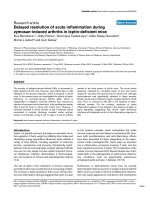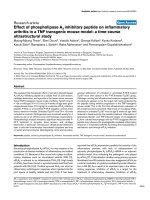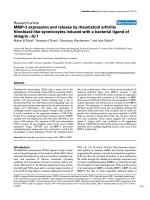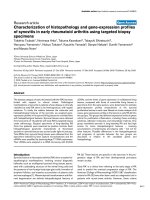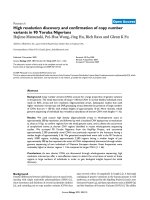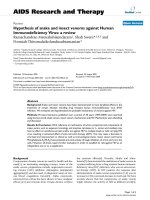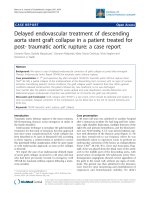Báo cáo y học: "Delayed intracardial shunting and hypoxemia after massive pulmonary embolism in a patient with a biventricular assist device" pdf
Bạn đang xem bản rút gọn của tài liệu. Xem và tải ngay bản đầy đủ của tài liệu tại đây (733.44 KB, 4 trang )
CAS E REP O R T Open Access
Delayed intracardial shunting and hypoxemia
after massive pulmonary embolism in a patient
with a biventricular assist device
Thomas Weig
1*
, Michael E Dolch
1
, Lorenz Frey
1
, Dirk Bruegger
1
, Peter Boekstegers
3
, Ralf Sodian
2
and
Michael Irlbeck
1
Abstract
We describe the interdisciplinary management of a 34-year-old woman with dilated cardiomyopathy thr ee months
postpartum on a cardiac biventricular assist device (BVAD) as bridge to heart transplantation with delayed onset of
intracardial shunting and subsequent hypoxemia due to massive pulmonary embolism. After emergency surgical
embolectomy pulmonary function was highly compromised (PaO
2
/FiO
2
54) requiring bifemoral veno-venous
extracorporeal membrane oxygenation. Transesophageal echo cardiography detected atrial level hypo xemic right-
to-left shunting through a patent foramen ovale (PFO). Percutaneous closure of the PFO was achieved with a PFO
occluder device. After placing the PFO occluder device oxygenation increased significantly (Δ p
a
O
2
119 Torr). The
patient received heart transplantation 20 weeks after BVAD implantation and was discharged from ICU 3 weeks
after transplantation.
An increase in pulmonary vascular resistance in patients on BVAD can reopen a PFO resulting in atrial right-to-left
shunting and subsequent hypoxemia. The case demonstrates the usefulness of transesophageal echocardiography
examinations in the detection of this unexpected event. Percutaneous placement of a PFO occluder device is an
appropriate strategy to stop intracardiac shunting through PFO in fixed elevation of pulmonary vascular resistance.
Keywords: patent foramen ovale, hypoxemia, pulmon ary embolism, ventricle-assist device, heart transplantation,
septal occluder device
Background
In a literature review, few cases of atrial level right-to-
left shunt in patients with left ventricular assist devices
are described. All these cases were detected either
intraoperatively [1-3] or within the first postoperative
days [4-7] . We describe a case of delayed onset of atrial
level right-to-left shunt after massive pulmonary embo-
lism on biventricular assist device (BVAD) support.
Case Presentation
A 34 year old female patient was admitted to our hospi-
tal with dilated cardiomyopathy three months after birth
of her third child. She had a known history of familial
dilated cardiomyopathy. Recompensation was not
achieved despite maximum medical therapy and inser-
tion of an intra-aortic balloon pump. BVAD [Excor, Ber-
lin Heart, Berlin, G ermany] was implanted using a bi-
atrial cannulation technique as bridge to heart trans-
plantation. Perioperative transesophageal echocardiogra-
phy did not show a patent foramen ovale (PFO).
Postoperative recovery was immediate and the p atient
was discharged from the ICU on the third post operative
day.
Four weeks after device implantation the patient
developed fulminant pulmonary embolism despite thera-
peutic anticoagulation. Emergency surgical embolectomy
for massive pulmonary embolism was performed since
thrombolysis was not an option after recent implanta-
tion of an artifici al heart (Figure 1). Pulmonary fu nctio n
was highly compromised after embolectomy and veno-
venous extracorporeal membrane oxygenation (ECMO)
[Bio-Console, Medtronic, Minneapolis, USA] was
* Correspondence:
1
Department of Anaesthesiology, Ludwig-Maximilians-University, Munich,
Germany
Full list of author information is available at the end of the article
Weig et al. Journal of Cardiothoracic Surgery 2011, 6:133
/>© 2011 We ig et al; licensee BioMed Central Ltd. This is an Open Access article distribute d under the terms of the Creative Commons
Attribu tion License ( which permits unres tricted use, distribution, and reproduction in
any mediu m, provided the original work is properly cited.
established using a bife moral ven ous acce ss. Wean ing
from veno-venous ECMO was achieved over the following
week but after removal oxygenation failure reoccurred.
F
i
O
2
of 1.0 was necessary to achieve sufficient o xygen
satur ation (p
a
O
2
/F
i
O
2
54). Modification of ventilator set-
ting with adjustments of PEEP and peak inspiratory pres-
sure did not lastingly improve oxygenation.
Transesophageal echocardiography detected atrial level
intracardial shunting (Figure 2). There was no improve-
ment after application of inhaled pulmonary vasodilata-
tors. CT-scan after surgical embolectomy showed residual
emboli in the pulmonary vascular system. Invasive proce-
dures such as r e-embolec tomy, topical thrombolysis or
catheter fragmentation were considered as too harmful or
not effect ive. Since right heart function was secured eve n
with high pulmonary vascular resistance, percutaneous
placement of a PFO occluder device [Amplatzer PFO
Occluder
®
, AGA Medical, Plymouth, USA] was performed
(Figure 2, Additional file 1). Oxygenation increased signifi-
cantly after placement without change of respirator set-
tings (Δ p
a
O
2
119 Torr). Weaning from mechanical
ventilation was successful after 15 weeks.
After 5 weeks of therapeutic anticoagulation the resi-
dual embo li diminished and pulmonary vascular resis-
tance was measured at 184 dyne•s/cm
5
with activated
assist device and 160 dyne•s/cm
5
with deactivated assist
device.
Heart transplantation was performed 20 weeks after
implantation of the BVAD and 16 weeks after pulmonary
embolism and placement of the PFO occluder device.
Discharge from ICU was 3 weeks after transplantation.
Informed consent for publication was obtained from the
patient.
Discussion
The problem with PFO and left ventricular assist device
leading to atrial level right-to-left shunt with consecutive
hypoxemia i s well described [1-7]. PFO has an incidence
up to 27% in normal healthy a dults as well as in adult
cardiac surgical p atients [8,9]. If left ventricular as sist
device (LVAD) is activated, left atrial unloading leads to
a decrease in left atrial pressure [10]. Right atrial pres-
sure exceeds left atrial pressure and with PFO atrial
level right- to-left shunt occurs. Depending on the shunt
fraction hypoxemia may occur [11].
Therefore, intraoperative transesophageal echocardio-
graphy with colour Doppler imaging and contrast with
agitated saline i s highly recommended before cardiopul-
monary bypass and after LVAD activation [12,13]. Alter-
natively, manual occlusion of the pulmonary artery
shortly before activatio n of the LVAD by the surgeon
and transesophageal echocardiography studies as
described are performed [14]. If PFO is detected before
weaning from cardiopulmonary bypass, immediate
operative closure is recommended. If shunting is
detected after weaning from cardiopulmonary bypass,
delayed interventional closure after stabilization is pre-
ferred if oxygenation failure is tolerable, since failure of
the right heart in LVAD implantation or bleeding com-
plications due to coagulopathy after reapplied bypass
Figure 1 CT-Scan: A & B before surgical embolectomy. C & D directly after surgical embolectomy.
Weig et al. Journal of Cardiothoracic Surgery 2011, 6:133
/>Page 2 of 4
can deteriorate outcome [2]. PFO closure improved oxy-
genation in all known cases as it did in our patient.
Ther e is only one other case of delayed onset of atrial
level right-to-left shunt in patients on ventricular assist
device [15]. In this case report, atrial level right-to-left
shunt wit h hypoxemia occurred after replacement of the
valves of a LVAD [LVAS, Novacor, Salt Lake City, USA]
which had been implanted one year before. The man-
agement consisted of reduction of right atrial pressure
by conservative means.
Persisting el evation of right atrial pressure due to per-
sisting change of the pulmonary vascular resistance in a
patient with a BVAD has not been described. An etiolo-
gic reason for persisting elevation of pulmonary vascular
resistance can be massive pulmonary embolism as
described in our case. Our report is the first description
of a patient surviving massive pulmonary embolism
while on BVAD, followed by succ essful orthotopic heart
transplantation. To the best of our knowledge there is
only one other published case of pulmonary embolism
in a patient with a BVAD. This patient died shortly after
the event [16].
Emergency surgical embolectomy is recommended in
hemodynamic unstable patients with massive pulmonary
embolism in a facility with cardiac surgical capabilities
[17]. Catheter embolectomy should be performed in
absence of cardiothoracic surgical backup [17]. In our
case, thrombolysis was contraindicated. Therefore emer-
gency surgical embolectomy was the treatment of
choice. The reported median reduction of pulmonary
vascular resistance achieved by surgical e mbolectomy is
from 893 ± 443.5 dyne•s/cm
5
to 285 ± 214 dyne•s/cm
5
[18], a result that was achieved in our patient.
With regard to the planned heart transplantation,
chronic thromboembolic pulmonary hypertension would
have been an exclusion criterion.
Conclusion
Diagnostic transesophageal echocardiography must be
performed with relevant change in the hemodynamic
Figure 2 Transesophageal echocardiography: A & B before, C & D after patent foramen ovale closure with a PFO occluder device
[Amplatzer PFO Occluder
®
, AGA Medical, Plymouth, USA].
Weig et al. Journal of Cardiothoracic Surgery 2011, 6:133
/>Page 3 of 4
situation and recurring hypoxemia in patients with VAD
since increase in pulmonary vascular resistance can
reopen PFO resulting in atrial level right-to-left shunting
and consecutive hypoxemia.
Consent
Written informed consent was obtained from the patient
for publication of this Case r eport and any accompany-
ing images. A copy of the written consent is available
for review by the Editor-in-Chief of this journal.
Additional material
Additional file 1: Transesophageal echocardiogram. Transesophageal
echocardiogram before and after patent foramen ovale closure with a
PFO occluder device [Amplatzer PFO Occluder
®
®, AGA Medical,
Plymouth, USA].
Author details
1
Department of Anaesthesiology, Ludwig-Maximilians-University, Munich,
Germany.
2
Department of Cardiovascular Surgery, Ludwig-Maximilians-
University, Munich, Germany.
3
Department of Cardiology, Helios Klinikum
Siegburg, Siegburg, Germany.
Authors’ contributions
TW reviewed the case, conducted a review of the literature and drafted the
manuscript. TW and MI performed the echocardiographic studies and
participated in the design of the case report. RS and PB performed the
operation and intervention described. MD, LF and DB confirmed the
patient’s diagnosis and revised the manuscript, contributing important
intellectual content. All authors read and approved the final manuscript.
Competing interests
The authors declare that they have no competing interests.
Received: 19 August 2011 Accepted: 11 October 2011
Published: 11 October 2011
References
1. Baker JE, Stratmann G, Hoopes C, Donateillo R, Tseng E, Russell IA:
Profound hypoxemia resulting from shunting across an inadvertent
atrial septal tear after left ventricular assist device placement. Anesth
Analg 2004, 98(4):937-940.
2. Kavarana MN, Rahman FA, Recto MR, Dowling RD: Transcatheter closure of
patent foramen ovale after left ventricular assist device implantation:
intraoperative decision making. J Heart Lung Transplant 2005, 24(9):1445.
3. Nguyen DQ, Das GS, Grubbs BC, Bolman RM, Park SJ: Transcatheter closure
of patent foramen ovale for hypoxemia during left ventricular assist
device support. J Heart Lung Transplant 1999, 18(10):1021-1023.
4. Bonvini RF, Verin V, Lerch R, Gerard I, Sierra J, Spratt JC: Percutaneous
closure of patent foramen ovale in a patient presenting arterial
hypoxaemia and supported with bi-ventricular assist device. Intensive
Care Med 2005, 31(4):602-603.
5. Loeffelbein F, Schlensak C, Beyersdorf F, Dittrich S: Successful
interventional closure of a patent foramen ovale in a pediatric patient
supported with a biventricular assist device. Interact Cardiovasc Thorac
Surg 2007, 6(6):778-779.
6. Loyalka P, Idelchik GM, Kar B: Percutaneous left ventricular assist device
complicated by a patent foramen ovale: importance of identification
and management. Catheter Cardiovasc Interv 2007, 70(3):383-386.
7. Srinivas CV, Collins N, Borger MA, Horlick E, Murphy PM: Hypoxemia
complicating LVAD insertion: novel application of the Amplatzer PFO
occlusion device. J Card Surg 2007, 22(2):156-158.
8. Augoustides JG, Weiss SJ, Weiner J, Mancini J, Savino JS, Cheung AT:
Diagnosis of patent foramen ovale with multiplane transesophageal
echocardiography in adult cardiac surgical patients. J Cardiothorac Vasc
Anesth 2004, 18(6):725-730.
9. Hagen PT, Scholz DG, Edwards WD: Incidence and size of patent foramen
ovale during the first 10 decades of life: an autopsy study of 965 normal
hearts. Mayo Clin Proc 1984, 59(1):17-20.
10. Nakatani S, Thomas JD, Savage RM, Vargo RL, Smedira NG, McCarthy PM:
Prediction of right ventricular dysfunction after left ventricular assist
device implantation. Circulation 1996, 94(9 Suppl):II216-221.
11. Godart F, Rey C, Prat A, Vincentelli A, Chmait A, Francart C, Porte H: Atrial
right-to-left shunting causing severe hypoxaemia despite normal right-
sided pressures - Report of 11 consecutive cases corrected by
percutaneous closure. Eur Heart J 2000, 21(6):483-489.
12. Chumnanvej S, Wood MJ, MacGillivray TE, Melo MF: Perioperative
echocardiographic examination for ventricular assist device
implantation. Anesth Analg 2007, 105(3):583-601.
13. Liao KK, Miller L, Toher C, Ormaza S, Herrington CS, Bittner HB, Park SJ:
Timing of transesophageal echocardiography in diagnosing patent
foramen ovale in patients supported with left ventricular assist device.
Ann Thorac Surg 2003, 75(5):1624-1626.
14. Majd RE, Kavarana MN, Bouvette M, Dowling RD: Improved technique to
diagnose a patent foramen ovale during left ventricular assist device
insertion. Ann Thorac Surg 2006, 82(5):1917-1918.
15. Kilger E, Strom C, Frey L, Felbinger TW, Pichler B, Tichy M, Rank N,
Wheeldon D, Kesel K, Schmitz C, et al: Intermittent atrial level right-to-left
shunt with temporary hypoxemia in a patient during support with a left
ventricular assist device. Acta Anaesthesiol Scand 2000, 44(1):125-127.
16. Beitzke D, Wieselthaler G, Schima H, Loewe C: Pulmonary embolism in a
patient with a biventricular assist device–imaging with multislice
computed tomography. Eur J Cardiothorac Surg 2011, 39(3):415
17. Samoukovic G, Malas T, deVarennes B: The role of pulmonary
embolectomy in the treatment of acute pulmonary embolism: a
literature review from 1968 to 2008. Interact Cardiovasc Thorac Surg 2010,
11(3):265-270.
18. Jamieson SW, Kapelanski DP, Sakakibara N, Manecke GR, Thistlethwaite PA,
Kerr KM, Channick RN, Fedullo PF, Auger WR: Pulmonary endarterectomy:
experience and lessons learned in 1,500 cases. Ann Thorac Surg 2003,
76(5):1457-1462.
doi:10.1186/1749-8090-6-133
Cite this article as: Weig et al.: Delayed intracardial shunting and
hypoxemia after massive pulmonary embolism in a patient with a
biventricular assist device. Journal of Cardiothoracic Surgery 2011 6:133.
Submit your next manuscript to BioMed Central
and take full advantage of:
• Convenient online submission
• Thorough peer review
• No space constraints or color figure charges
• Immediate publication on acceptance
• Inclusion in PubMed, CAS, Scopus and Google Scholar
• Research which is freely available for redistribution
Submit your manuscript at
www.biomedcentral.com/submit
Weig et al. Journal of Cardiothoracic Surgery 2011, 6:133
/>Page 4 of 4


